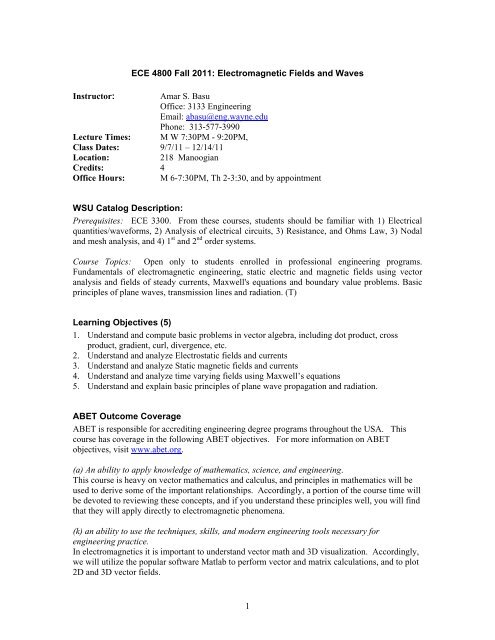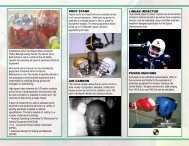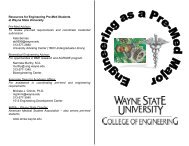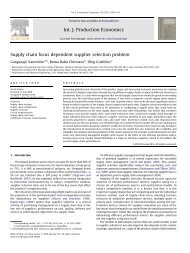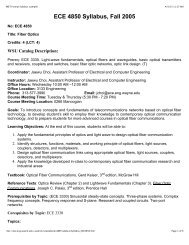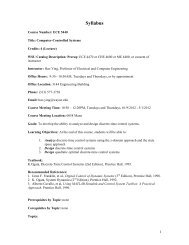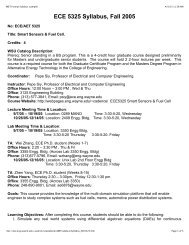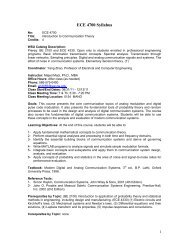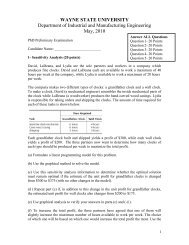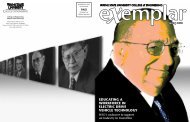ABET Format Syllabus for ECE 4800
ABET Format Syllabus for ECE 4800
ABET Format Syllabus for ECE 4800
- No tags were found...
You also want an ePaper? Increase the reach of your titles
YUMPU automatically turns print PDFs into web optimized ePapers that Google loves.
<strong>ECE</strong> <strong>4800</strong> Fall 2011: Electromagnetic Fields and WavesInstructor:Amar S. BasuOffice: 3133 EngineeringEmail: abasu@eng.wayne.eduPhone: 313-577-3990Lecture Times: M W 7:30PM - 9:20PM,Class Dates: 9/7/11 – 12/14/11Location:218 ManoogianCredits: 4Office Hours: M 6-7:30PM, Th 2-3:30, and by appointmentWSU Catalog Description:Prerequisites: <strong>ECE</strong> 3300. From these courses, students should be familiar with 1) Electricalquantities/wave<strong>for</strong>ms, 2) Analysis of electrical circuits, 3) Resistance, and Ohms Law, 3) Nodaland mesh analysis, and 4) 1 st and 2 nd order systems.Course Topics: Open only to students enrolled in professional engineering programs.Fundamentals of electromagnetic engineering, static electric and magnetic fields using vectoranalysis and fields of steady currents, Maxwell's equations and boundary value problems. Basicprinciples of plane waves, transmission lines and radiation. (T)Learning Objectives (5)1. Understand and compute basic problems in vector algebra, including dot product, crossproduct, gradient, curl, divergence, etc.2. Understand and analyze Electrostatic fields and currents3. Understand and analyze Static magnetic fields and currents4. Understand and analyze time varying fields using Maxwell’s equations5. Understand and explain basic principles of plane wave propagation and radiation.<strong>ABET</strong> Outcome Coverage<strong>ABET</strong> is responsible <strong>for</strong> accrediting engineering degree programs throughout the USA. Thiscourse has coverage in the following <strong>ABET</strong> objectives. For more in<strong>for</strong>mation on <strong>ABET</strong>objectives, visit www.abet.org.(a) An ability to apply knowledge of mathematics, science, and engineering.This course is heavy on vector mathematics and calculus, and principles in mathematics will beused to derive some of the important relationships. Accordingly, a portion of the course time willbe devoted to reviewing these concepts, and if you understand these principles well, you will findthat they will apply directly to electromagnetic phenomena.(k) an ability to use the techniques, skills, and modern engineering tools necessary <strong>for</strong>engineering practice.In electromagnetics it is important to understand vector math and 3D visualization. Accordingly,we will utilize the popular software Matlab to per<strong>for</strong>m vector and matrix calculations, and to plot2D and 3D vector fields.1
(h) the broad education necessary to understand the impact of engineering solutions in a global,economic, environmental, and societal contextElectromagnetics is a fundamental topic necessary to understand electrical and electronicdevices/phenomena. During class we will find some common(e) an ability to identify, <strong>for</strong>mulate, and solve engineering problemsElectromagnetics is a challenging course in problem solving. In this course you will learn groupsof techniques used to solve canonical problems in electrostatics and magnetostatics. In examsand homework, there may be more than one way to solve the problem, and you will need tochoose which approach is most appropriate <strong>for</strong> problems.Textbook and Other resources:Course textbook: D. Cheng, Fundamentals of Engineering Electromagnetics, Prentice Hall.If you are confused about a topic in our textbook or my lecture notes, try to look up additionalreferences in the list below. Whether you end up in industry or grad school, it is very importantto learn how to independently become an expert in a new subject.Popular textbooks in semiconductor physicso D. Cheng, Electromagnetic Fields and Waveso Ulaby Fundamentals of Applied ElectromagneticsMIT Open Courseware (http://ocw.mit.edu/courses/electrical-engineering-and-computerscience/6-013-electromagnetics-and-applications-fall-2005/)Hyperphysics (http://hyperphysics.phy-astr.gsu.edu/hbase/hframe.html). Click the circlewhich says “Electricity and Magnetism”.Other online sources such as Wikipedia (http://www.wikipedia.org). Be careful with onlinesources because their accuracy cannot be verified.Course Modules (Tentative)1. Introduction/Motivation – why study semiconductor device physics2. Vector Calculusa. Review of matrix mathb. Vector addition/subtractionc. Vector Multiplication – Dot product and Cross productd. Review of 3D coordinate systems – Cartesian, cylindrical, sphericale. Gradientsf. Divergenceg. Curlh. Stokes Theorem3. Static Electric Fields (Electrostatics)a. Fundamental rules of analysisb. Coulomb’s Lawc. Gauss’s Lawd. Electric potentiale. Material media in static electric fields – conductors and dielectricsf. Electric flux density, definition of dielectric constantg. Boundary conditions <strong>for</strong> electrostatic fieldsh. Capacitance/capacitorsi. Electrostatic energy and <strong>for</strong>ces2
j. Solving electrostatic boundary problems4. Steady Electric Currents (also part of electrostatics)a. Current Density and Ohm’s Lawb. Equation of Continuity and Kirchoff’s Lawc. Power Dissipation and Joule’s Lawd. Calculating Resistance5. Static Magnetic Fields (Magnetostatics)a. Fundamentals of magnetostatic analysisb. Vector magnetic potentialc. Biot-Savart Lawd. Magnetic Dipolese. Magnetization and Equivalent Current Densitiesf. Magnetic Field Intensity and Magnetic Permeabilityg. Magnetic materialsh. Boundary conditionsi. Inductances/Inductorsj. Magnetic Energyk. Magnetic Forces and Torques – DC motors Static6. Time Varying Fields and Maxwell’s Equationsa. Faradays Lawb. Maxwell’s equations – integral <strong>for</strong>m and electromagnetic boundary conditionsc. Potential Functionsd. Time-Harmonic Fields – phasors, field analysis, electromagnetic spectrum7. Plane Electromagnetic Wavesa. Plane waves in Lossless Media – dopper effect, transverse/longitudinal, polarizationb. Plane waves in Lossy Media – Low-loss dielectrics, good conductorsc. Group velocityd. Flow of electromagnetic power, Pointing Vectore. Normal incidence of plane waves at planar boundariesf. Oblique incidence of plane waves at planar boundaries – total reflection, polarization,Brewster angle, Snell’s law8. Transmission lines (if time permits)a. Transmission line equationsb. Transmission line parametersc. Infinite transmission linesd. Finite transmission linese. Smith Chartf. Transmission line impedance matchingAttendance Policy:Students are required to attend class, and attendance will be taken if necessary. 3 absences areallowed <strong>for</strong> documented personal/medical reasons. Please email me in advance if you knowyou will miss a class.However, on the following dates, attendance is absolutely mandatory. No makeup exams will begiven, so please email me within the first week of classes if you have a conflict on these dates.Midterm 1: Monday, October 3rd during classMidterm 2: Monday, November 14 th during classFinal exam: Wednesday, December 14 th during regular class time3
Grading Policy: 15% Homework. There will be 3-5 homework assignments.Homework is due at the beginning of the lecture. 3 late days allowed, maximum 2 late daysper assignment. After that, HW will not be accepted <strong>for</strong> credit. 45% Two midterms (each 22.5%) 35% Final exam 5% reserved <strong>for</strong> attendance, and pop quizzes if necessaryGrading scale (subject to change)A 94-100A- 90-93B+ 85-89B 80-84B- 75-79C+ 70-74C 65-69C- 60-64D 50-59E 0-494
Cheating Policy and Penalty <strong>for</strong> Cheating:Cheating is defined by the University as “intentionally using or attempting to use, or intentionallyproviding or attempting to provide, unauthorized materials, in<strong>for</strong>mation, or assistance in anyacademic exercise.” This includes any group ef<strong>for</strong>ts on assignments or exams unless specificallyapproved by the professor <strong>for</strong> that assignment/exam. Evidence of fabrication or plagiarism, asdefined by the University in its brochure Academic Integrity, will also result in downgrading <strong>for</strong>the course. Students who cheat on any assignment or during any examination will be assigned afailing grade <strong>for</strong> the course.Blackboard:We will use the WSU blackboard website extensively in this course. Please log on tohttp://blackboard.wayne.edu and make sure you have access to <strong>ECE</strong> 4570 course website. Ourblackboard site will be used <strong>for</strong> the following:Lecture slides, homeworks, and course in<strong>for</strong>mation will be posted. I will plan to uploadlecture slides at least 2 hours be<strong>for</strong>e lecture begins. Please print them out and bring them toclass with you.Lecture and homework related questions Discussion boards in blackboard will be used topost answers to questions related to the lectures and homework. Please post your questions tothe appropriate blackboard discussion group. I will be checking them periodically and willpost answers as soon as possibleAnonymous feedback: There is a blackboard discussion group specifically <strong>for</strong> anonymouscourse feedback. Please be sure to check the ‘anonymous’ box and feel free to give yourhonest feedback and constructive criticism about how the course can be improved.Grades: You will be able to access your current grades at any time.Urgent notices: Those who have registered with the WSU emergency alert system canreceive text messages on your cell phone. I will use the broadcast system in case of lastminute class cancellations or other urgent notices.Feedback:I as well as the <strong>ECE</strong> department value your feedback in how we can make this course better andbetter serve your needs. The standard WSU course evaluations will also be given at the end of the term. We may have midterm teaching evaluations of the course sometime in the middle of thesemester.Anonymous feedback can be posted anytime through blackboard.If you have any personal issues with the course, please come to office hours or setup anappointment to speak with me individually5


